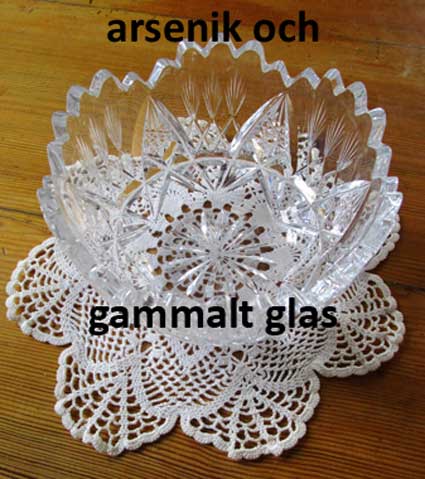
| VISIT US |
Bergdala glastekniska museum
|
|

|
||
|
For other languages we offer / för andra språk erbjuder vi
- The processes from an environmental perspective - Environmental problems, history and future - Why "Kingdom of crystal"? |
|
The glass industry, what is done to the problems? |
|
|
What is done to deal with the environmental problems around the glassworks and other process industries?
We Swedes often compliment ourselves for our environmental awareness so let us look at how little our environmental laws have evolved and what that means. Let us consider one of the (formerly) common fining agents to illustrate the origins and development of the Swedish environmental laws, namely arsenic.
Throughout history, arsenic has been used in many different ways, but without going into too many details,
one can say that the use as insecticide, paints and dyes, and as fining agent for glass melts has been
dominant.
In 1876 a new law was introduced, called the arsenic regulation, which actually consisted of two different lists of toxic substances. Substances on one of them had to be sold by pharmacists or by the manufacturer of the substance. Substances on the second list could be sold by the traders who had reported that s/he intended to deal with that particular substance. Furthermore, the poisons on this second list could only be sold on prescription, or to traders, not to private individuals. Around the same time the labour movement in Sweden began to form, and both safety and work environment came to play a major role. In the 1890s came the first Safety and Health Act. At that time, it was the accidents: falling, collapsing structures, fire and the like that were seen as the big problems for the workers - not slow-acting poisoning. |

|
||
|
The arsenic regulation contained, however - among other things - rules on maximum arsenic levels in certain products. For example, one could not import fabrics dyed with arsenic dyes. This was, of course, not popular among business trade associations or by foreign manufacturers. Lobby work against the arsenic regulation led to the 1906 poison charter, which became a form of "arsenic regulation light". According to the new poison charter, some substances could now be sold to private individuals to exterminate flies, rats and similar vermin. The 1906 poison charter was changed many times over the years until 1943 when a new and revised charter came. This charter was revised in the 1950s and resulted in the first more modern regulation of toxins and harmful substances. Around the same time, in the early 1960s, the role of poisons in the working environment began to be noticed. This was also the time when environmental issues in general came into public consciousness. More and more specialized environmental regulations were introduced in different areas and the legislation became more and more confusing. Four years after the Swedish EU membership, on 1 January 1999 a comprehensive environmental legislation was introduced - the Environmental Code - which replaced sixteen different Swedish environmental laws with a single one, and also made the Swedish environmental legislation adapted to the federal EU law. About the same time, around the year 2000, work was started to find a possible replacement of arsenic as a fining agent in the glass, by antimony. Antimony is about as toxic as arsenic but more difficult to vaporize. Therefore, it will not enter the atmosphere in the working environment nor the external environment as easily as arsenic. Arsenic has been used in glass manufacturing for several hundred years whereas we have only had a reasonably coherent environmental legislation for less than 20 years. Is it any wonder that the ground around the glassworks often contain fairly high levels of arsenic and other substances? Lead, for example, which is a major component of crystal glass. |
|||
|
It is obvious that the ground around process industries such as glassworks is contaminated with many and various toxic substances. Therefore, there have been several surveys done to identify the problems. Such surveys were started in a broader scale about 2000 after the Environmental Protection Agency had developed a general method for how to proceed. According to this method polluted areas are classified as highly contaminated, Class 1, and these areas are now tackled with the help of state subsidies. Of a total of nearly 3300 contaminated areas throughout Sweden less than half - around 1300 - are Class 1 and decontamination of these are still ongoing in 2016. When they are done, work will begin on the less polluted Class 2 areas. Many glassworks grounds - like Bergdala - are Class 2. But the industry is not just waiting - there is ongoing research and development work to find ways to deal with the problems. For example, the Glass Research Institute in Växjö has a project called "Från usch till resurs" ("From blaah to bravo", "From pest to provision"?) aiming to find a method to re-use the materials from the glass dumps. Results should be available in 2018. Until then we have to live with the problems and the risks, homeowners and visitors alike. |
|||